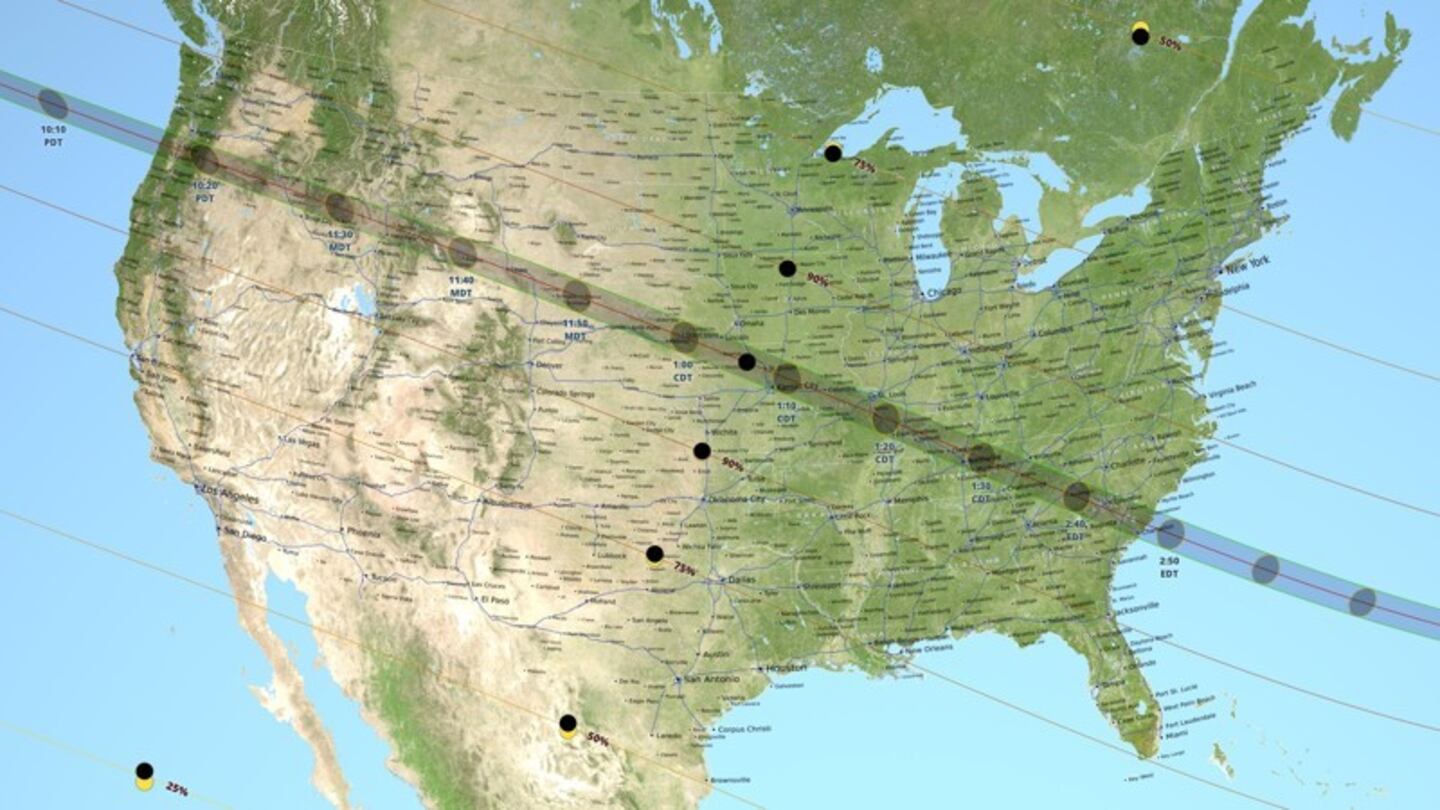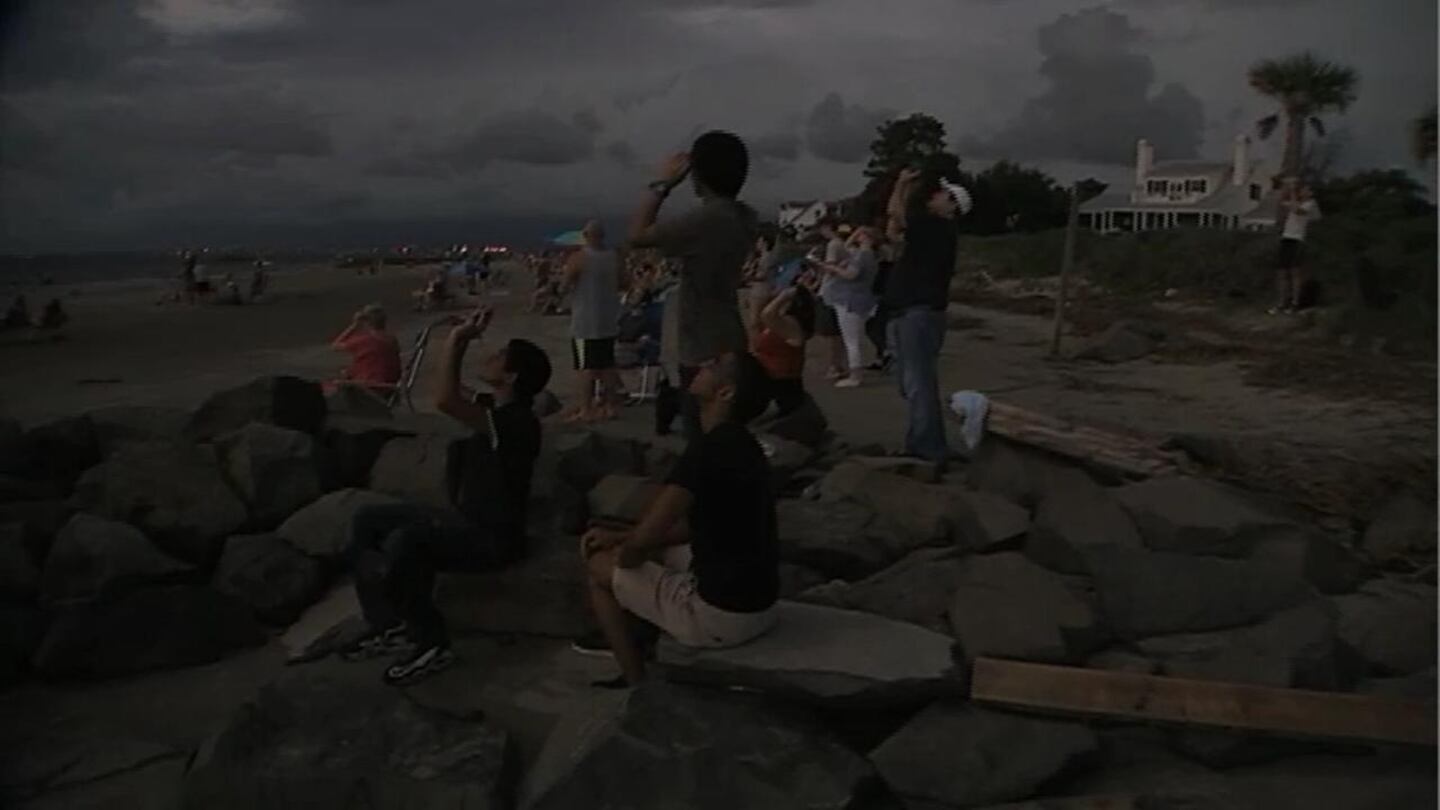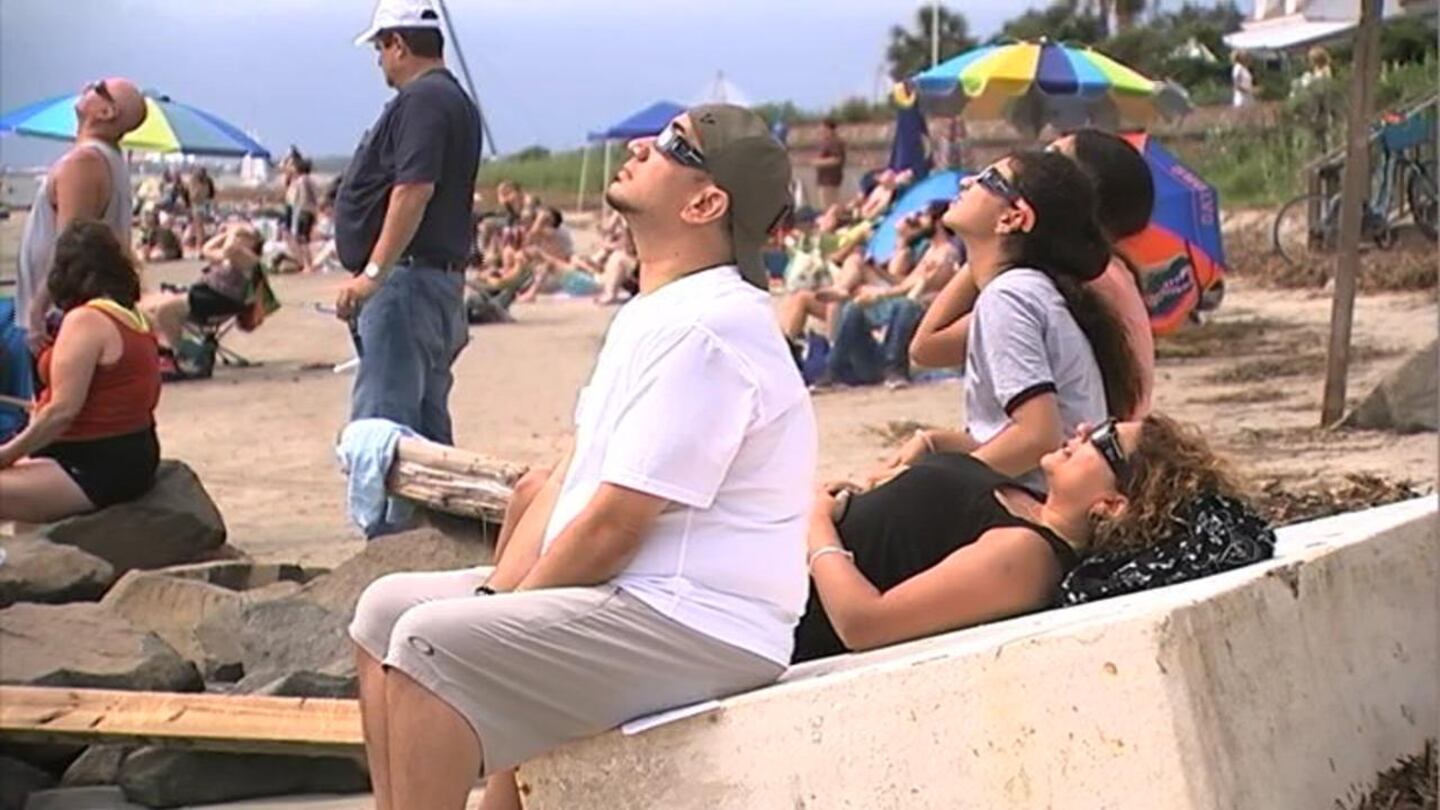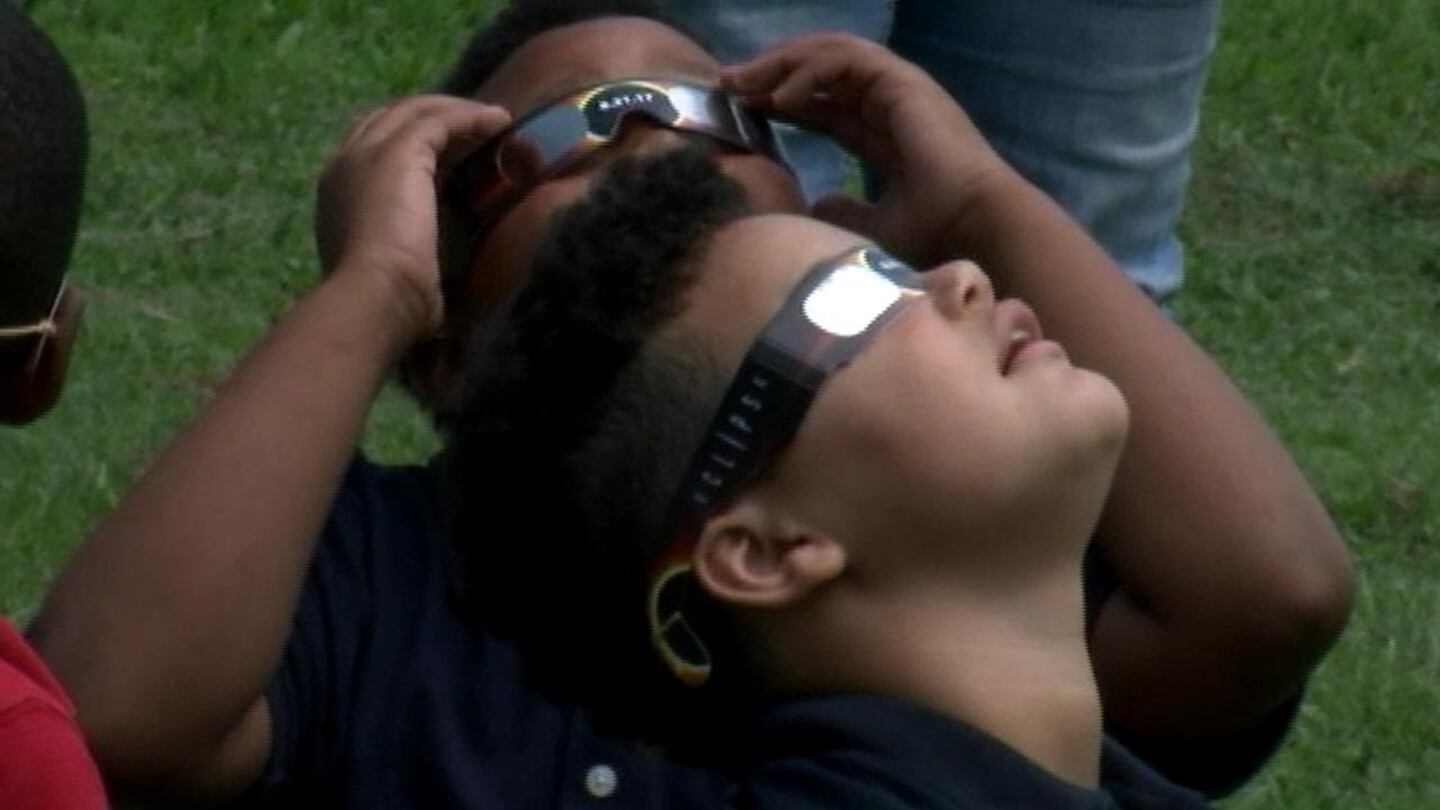It was a moment that millions of people waited on for years: The Great American Solar Eclipse.
[SOLAR ECLIPSE: Special Section]
The shadow — a corridor just 60 to 70 miles wide — came ashore in Oregon and then traveled diagonally across the Midwest to South Carolina, with darkness from the totality lasting only about two to three wondrous minutes in any one spot.
The path of totality passed through 14 states, entering near Lincoln City, Oregon, at 1:16 p.m. EDT, moving over Casper, Wyoming; Carbondale, Illinois; and Nashville, Tennessee, and then exiting near Charleston, South Carolina, at 2:47 p.m. EDT.
People from all over came to the Carolinas to witness the astronomical phenomenon, where 100 percent totality could be seen in places like Greenville and Charleston.
"I thought it was amazing, It kind of made me tear up toward the end there. I thought it was just amazing to watch," said Breanna Erlenmeyer, who watched to the eclipse in Greenville.
The rest of North America was treated to a partial eclipse, as were Central American and the top of South America.
With 200 million people within a day's drive from the path of totality, towns and parks saw big crowds. Skies were clear along most of the route, to the relief of those who feared cloud cover would spoil this once-in-a-lifetime moment.
[PHOTOS: Great American Eclipse Viewing in the Carolinas]
"I've never seen it in my lifetime, and I doubt my daughter will ever get to see it again in her lifetime," said John White.
He headed to Columbia to see the eclipse, as did millions of other people.
Eclipse coverage:
- Solar Eclipse 2017: Google Doodle marks sky show
- Solar Eclipse 2017 in photos
- Eye damage from eclipse can show later: What you need to know
- Miss Monday's eclipse? 2024 view from other U.S. cities will be better
- Most Stunning Moments From The Total Eclipse
- Total Solar Eclipse 2017
- Baby named Eclipse born in South Carolina
The 100 percent totality moment was an incredible view as the sky went from total darkness and then a glow ring surrounded the moon.
What made the August eclipse so remarkable was the moon was close in its orbit to the earth when it passed and completely overshadowed the sun.
Two-hundred million people live within a day's drive of Monday's path of totality. So towns and parks along the eclipse's main drag have welcomed monumental crowds. The last coast-to-coast eclipse was in 1918.
Authorities prepare for traffic congestion before and after solar eclipse
North Carolina Department of Transportation officials and state troopers say they are focusing their resources in the western part of the state where roadwork will be restricted.
More than 2 million people were expected to drive through the Carolinas on Monday, with the biggest destinations being South Carolina cities like Columbia, Charleston and Greenville.
In South Carolina, officials added more patrols and opened lanes as people make their way to the once-in-a-lifetime event.
Many people were able to space out their trips over the weekend but most of them will start to drive home as soon as the eclipse is over, meaning some of the biggest traffic trouble could happen during the evening rush hour.
The NCDOT set up three extra traffic cameras and positioned four State Farm safety trucks near the interstate. When traffic starts to become an issue, they will use dozens of message boards to communicate with drivers.
In South Carolina, the Highway Patrol limited construction so road work won't slow down drivers. Most of the congestion is expected along interstates like I-77 but could also spill over onto side streets.
SCDOT officials said there were backups along southbound I-95 near I-26, I-85 in both directions and northbound I-77 near Columbia.
Officials also warned drivers that rest stops were over capacity in some spots in South Carolina and had to temporarily close down.
Cashing in on the eclipse
The Charlotte area saw a huge surge in tourists, and local restaurants were prepared for Monday’s solar eclipse.
Businesses across the Carolinas cashed in on the once-in-a-lifetime event. Cities like Columbia and Charleston were in line for 100 percent totality, so many people were flying into Charlotte and renting cars to drive south.
Channel 9 checked several rental companies and found most are booked. Hotels as far away as Mount Holly were also selling out.
More than 9,400 people used Airbnb while staying in South Carolina for the eclipse. The company expects to bring an extra $2 million in income to residents sharing their homes.
Charleston expected the most guests, with more than 3,000 booked, followed by Mount Pleasant, Greenville and Columbia.
Nearly 2 million people expected in Charleston for total solar eclipse viewing
Travel experts are expecting nearly two million people to be in Charleston Monday afternoon for the total solar eclipse.
At 2:46 p.m., the sun completely covered by the moon and reached total darkness in Charleston for about two minutes.
Channel 9 meteorologist Vicki Graf went to Charleston to cover the eclipse and spoke to a lot of people who traveled from other states and have been planning the trip for a year.
"It's the once in my lifetime, I'm 63 and I'm quickly running out of years to see one," said Geoff Patton.
Graf even met people visiting from Australia as well as a news crew from France.
Rain moved through Charleston early Monday morning and some were concerned that low clouds would obscure the view, but as the solar eclipse got underway, there were enough breaks in the clouds to have good viewing conditions.
"It was awesome. It was an awe moment. I have been waiting for this for the past four years," said Terwill and Chuck Tomino. "It was surreal. I twas awesome just seeing everything just go quiet and dark and then hear everyone cheer."
Graf spoke with a family who drove from New Hampshire and has been planning the trip for a year.
"There are people from all over the country here, so it's pretty cool,” Jerry Stajeuha said. “We’re very excited to experience the totality thing if at all possible."
(Scroll below for social media updates on The Great American Eclipse coverage)
Area schools plan to use eclipse to educate
Nearly every public school in our area was either out of class or dismissed early for Monday's eclipse, except for Chester County.
The district decided to hold a full schedule of classes, and even extended the school day. School officials bought more than 5,000 pairs of eclipse glasses for the students and they plan to stream the eclipse live for the younger grades.
"This may be our learning moment, this may be the moment we teach them something that stays with them," said Lewisville Middle School teacher Kenneth Snipes.
Teachers also provided an eye safety lesson before the eclipse. All parents were sent a letter allowing them to opt-out if they don't want their children to watch the eclipse.
South Carolina actually scheduled districts to go back to school earlier this year so students could learn about the eclipse in class before it happened.
Michelle Chase, the media specialist at great Falls Elementary School said she's preparing a projection camera with binoculars for the students.
“They’re looking forward to it. We’ve planned all kinds of activities and games,” she said.
Chase said children will have eclipse glasses but she wanted them to have an alternative way to look at the eclipse as well.
Before the big event, kids were learning all about the science behind the eclipse and told Channel 9 that they’re ready to see it in action.
"A total solar eclipse is when moon passes directly between the sun and the earth," said 5th grader Julia Wertz.
York, Fort Mill, Clover, Rock Hill and Lancaster schools all had half days Monday and dismissal times vary depending on the school.
Chesterfield County did not have school Monday.
Once-in-a-lifetime experience
Over the past 2,000 years, South Carolina has experienced 21 solar eclipses, but the last one to pass over Charleston was on March 7, 1970, which was the last solar eclipse to cross South Carolina.
The next solar eclipse is expected in 2024 and South Carolina will not be in the path of totality.
Channel 9 reporter Greg Suskin was at Conestee Nature Park in Greenville, South Carolina as hundreds gathered to witness the eclipse, including a family from Long Island.
"In Long Island, we've never had that kind of total eclipse and my husband is very interested, so I'm along for the ride," said Jeanine Dykeman.
People scoped out the best spots to catch the eclipse for weeks and months and many were heading to the mountains.
Channel 9 reporter Ken Lemon made his way to Crowders Mountain, where officials said they were prepared for the crowds.
The phone rang off the hook Monday morning with people wanting to make sure the park was open for viewing.
The park had an auditorium ready with a livestream from NASA of the eclipse as it happens, but officials know most people want to see it from a high elevation.
Wingate University Ballantyne also hosted a solar eclipse viewing party. Organziers estimate about 4,000 people came out to watch history at Ballantyne Corporate Park.
Angela Spinelli and her 9-year-old daughter Olivia arrived early with a wagon full of supplies to claim their viewing spot and take in the solar eclipse.
"This is awesome. One of the best days of my life, Just love to be here with her and enjoying this moment," Angela Spinelli said after the eclipse occurred.
The Great American Eclipse from coast-to-coast
Millions of Americans gazed in wonder through telescopes, cameras and disposable protective glasses Monday as the moon blotted out the sun in the first full-blown solar eclipse to sweep the U.S. from coast to coast in nearly a century.
"It was a very primal experience, it really was," Julie Vigeland, of Portland, Oregon, said after she was moved to tears by the sight of the sun reduced to a silvery ring of light in Salem. "I've seen other really magnificent things, but there is nothing, nothing like this. Absolutely nothing."
The temperature dropped, birds quieted down, crickets chirped and the stars came out in the middle of the day as the line of darkness raced 2,600 miles (4,200 kilometers) across the continent in about 90 minutes, bringing forth oohs, aahs, shouts and screams.
In Boise, Idaho, where the sun was more than 99 percent blocked, people clapped and whooped, and the street lights came on briefly, while in Nashville, Tennessee, people craned their necks at the sky and knocked back longneck beers at Nudie's Honky Tonk bar.
Passengers aboard a cruise ship in the Caribbean watched it unfold as Bonnie Tyler sang her 1983 hit "Total Eclipse of the Heart."
At the Nashville Zoo, the giraffes and rhinos started running around crazily when the sun came back. Several minor-league baseball teams — one of them, the Columbia Fireflies, outfitted for the day in glow-in-the-dark jerseys — briefly suspended play.
At the White House, despite all the warnings from experts about the risk of eye damage, President Donald Trump took off his eclipse glasses and looked directly at the sun.
It was the most-observed and most-photographed eclipse in history, with many Americans staking out prime viewing spots and settling onto blankets and lawn chairs to watch, especially along the path of totality — the line of deep shadow created when the sun is completely obscured except for the ring of light known as the corona.
NASA reported 4.4 million people were watching its TV coverage midway through the eclipse, the biggest livestream event in the space agency's history.
"It can be religious. It makes you feel insignificant, like you're just a speck in the whole scheme of things," said veteran eclipse-watcher Mike O'Leary of San Diego, who set up his camera along with among hundreds of other amateur astronomers gathered in Casper, Wyoming.
John Hays drove up from Bishop, California, for the total eclipse in Salem, Oregon, and said the experience will stay with him forever.
"That silvery ring is so hypnotic and mesmerizing, it does remind you of wizardry or like magic," he said.
More than one parent was amazed to see teenagers actually look up from their cellphones.
Matt Nagy, of Laramie, Wyoming, said that the eclipse made him "whoop and holler" and that even his two teenage daughters were impressed: "It takes a lot to get a teenager excited about something."
Astronomers were giddy with excitement. A solar eclipse is considered one of the grandest of cosmic spectacles.
NASA solar physicist Alex Young said the last time earthlings had a connection like this to the heavens was during man's first flight to the moon, on Apollo 8 in 1968. The first, famous Earthrise photo came from that mission and, like this eclipse, showed us "we are part of something bigger."
NASA's acting administrator, Robert Lightfoot, watched with delight from a plane flying over the Oregon coast and joked about the NASA official next to him: "I'm about to fight this man for a window seat."
Hoping to learn more about the sun's composition and activity, NASA and other scientists watched and analyzed from telescopes on the ground and in orbit, the International Space Station, airplanes and scores of high-altitude balloons beaming back live video.
Citizen scientists monitored animal and plant behavior as day turned into twilight. Thousands of people streamed into the Nashville Zoo just to watch the animals' reaction and noticed how they got noisier at it got darker.
The Earth, moon and sun line up perfectly every one to three years, briefly turning day into night for a sliver of the planet. But these sights normally are in no man's land, like the vast Pacific or Earth's poles. This is the first eclipse of the social media era to pass through such a heavily populated area.
The moon hasn't thrown this much shade at the U.S. since 1918, during the nation's last coast-to-coast total eclipse. The last total solar eclipse on the U.S. was in 1979, but only five states in the Northwest experienced total darkness.
The next total solar eclipse in the U.S. will be in 2024. The next coast-to-coast one will not be until 2045.
Read more top trending stories on wsoctv.com:
- TOTAL SOLAR ECLIPSE: Excitement builds as big day arrives
- Is it safe to take a selfie with the eclipse? How to do it the right way
- CMPD: Uncle, nephew shot during robbery in 'quiet' neighborhood
- WATCH: Keith Monday's eclipse forecast outlook
- Monroe police officer, high school resource officer mourned by community
- Solar Eclipse 2017: NASA live stream, live updates
Cox Media Group










